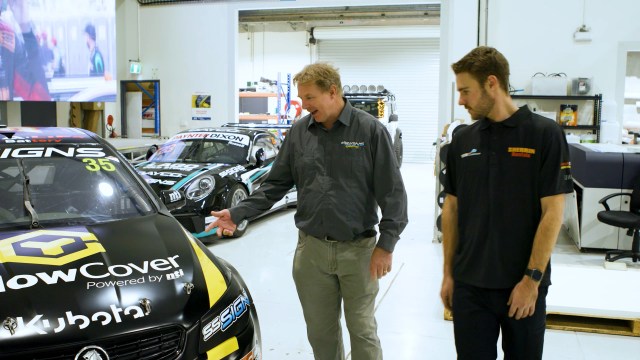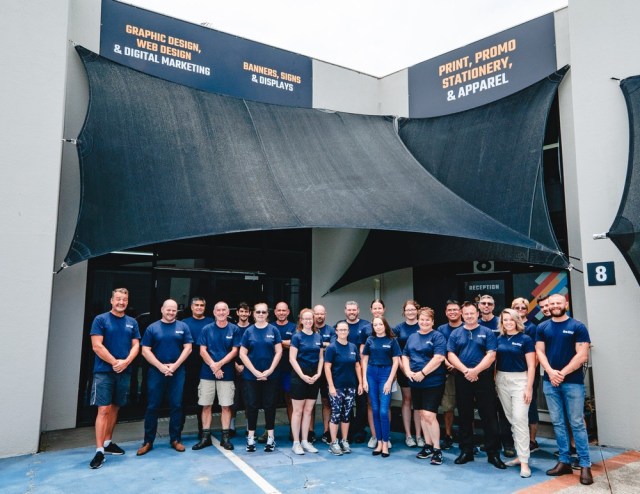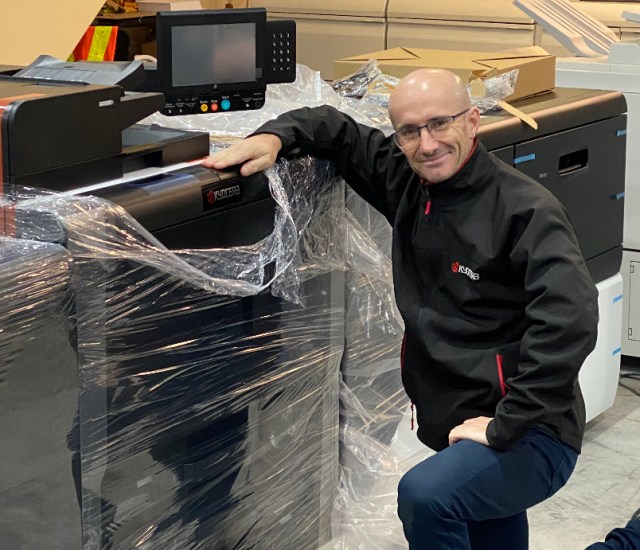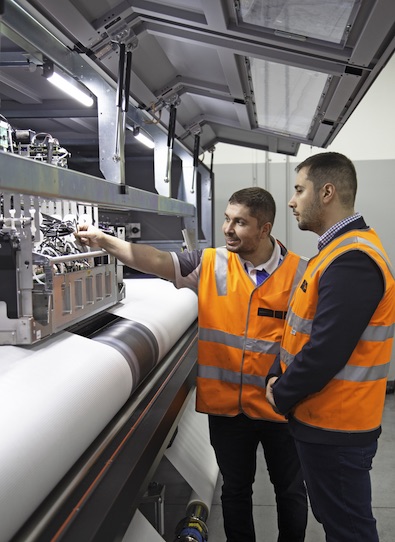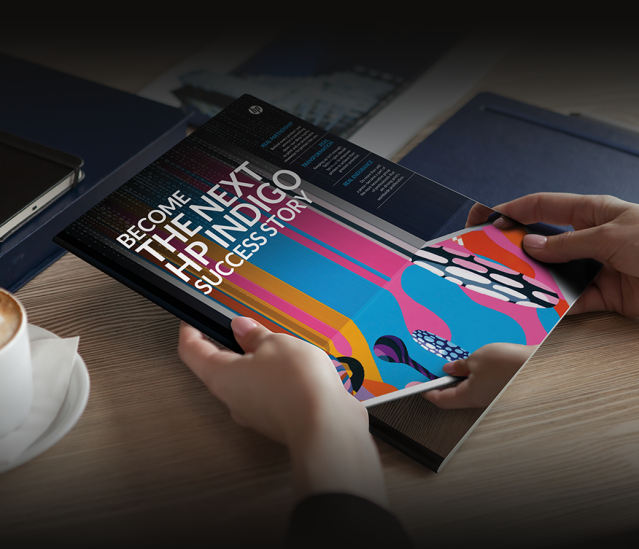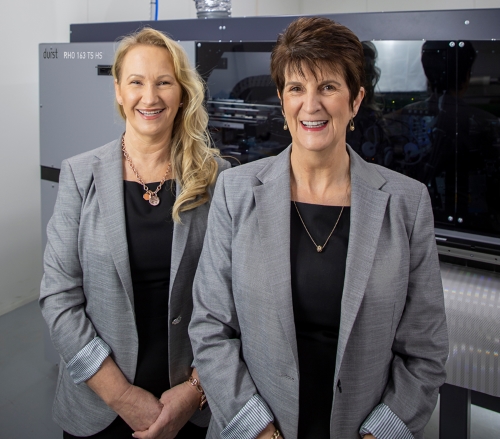
Wendy Bezzina (known to the industry as Wen) runs a unique organisation that is unlike many – she is the CEO of Latrobe Valley Enterprises (LVE), a not-for-profit social enterprise in Victoria with a network of commercially viable businesses that creates meaningful and sustainable employment opportunities for people with disabilities. Having been in business for 54 years, a pressing need for LVE was to develop the sign making arm of its operations to keep up-to-date with the nature of today’s demands and modern-day technology. With Wen at the helm, the organisation went on the hunt for a large format press manufacturer that could deliver on its needs.
It wasn’t long before Wen came across Durst and its fleet of productive, high-quality industrial traffic sign production machines. Within just a few months, LVE chose Durst and has become a first-time customer of the business, having purchased its Rho 163 TS HS traffic sign printer.
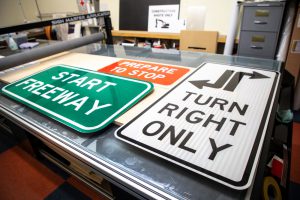
“We were really impressed with the equipment and its capabilities. For us, because we had equipment that were much older, just to see the speed of the Durst Rho 163 TS was amazing,” Wen said.
“There are so many opportunities that the Durst traffic sign printer presents us with – it is one of the only few in Australia with six-colour capabilities. We can do roll-to-roll printing, flatbed printing, and the fact that it has UV capabilities shows that Durst is a leader in the marketplace.
“The Rho 163 TS HS traffic sign printer suits our evolving needs, and is reliable and consistent with our 10-year plan moving forward. Machines from other manufacturers just didn’t match up to the level of what we had seen with the Durst press.”
A unique establishment
LVE was founded in 1967 by a small group of community members.
It started out as a sheltered workshop, a fairly common establishment in the ‘50s and the early ‘60s.
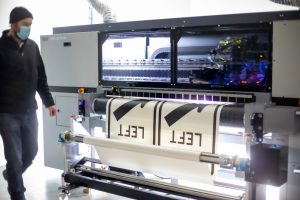
“Back then, the thought process was that people with disabilities could only perform the simplest of tasks. In the initial stages, we employed only six people that stuck mosaic tiles to flower pots,” Wen said.
1969 was the turning point for the organisation; it was when local paper manufacturers donated an engraving machine to LVE and also granted the social enterprise with a contract to produce industrial tags for the mill.
By 1972, the LVE workshop had three engraving machines that were all donated and had a number of contracts in place with the State Electricity Commission Victoria (SECV), the paper mill, and a number of other organisations.
“By 1974, we had about 40 employees. By 2009, we moved into the building that we’re in now – at Morwell, Victoria. This building is more purpose-built as it includes a corporate office and factory,” Wen mentioned.
Fast forward to today, the establishment currently has 111 employees, of which 86 of them are people with disabilities.
The organisation has five business sectors – sign making, business support services, grounds maintenance, recycling and secure document destruction services.
It has also recently taken on the facilities management of a local caravan park, adjacent to a nearby hospital, providing visiting medical staff with much needed accommodation.
Within its sign making business, LVE services national companies and has in place a number of contracts with the Federal Government.
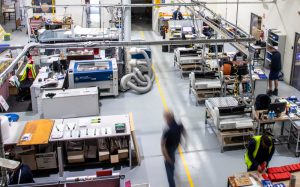
“We also work with a lot of organisations to meet the requirements of the Victorian Social Procurement Framework,” Wen said.
“Within the sign making business itself, we manufacture braille tactile signs, vinyl and window signs, industrial signs and labels, door and wall signs informational signs, and directional signs, amongst other signage solutions.”
As LVE is known for its braille signs, it had in place a number of small CNC routing machines, a Roland flatbed printer and a Roland printer and kiss-cutting machine for stickers.
“The equipment is all at least 10 years old, if not more,” Wen said.
“That was all we had in our facilities as far as modern equipment went.
“We then went on to buy two new laser cutters to expand and speed up our current product offering.”
Discovering Durst
Wen was conscious that LVE hadn’t invested a lot of money within the sign making arm of the business, which meant that opportunities of growth were going to be limited if it didn’t upgrade its equipment. She started looking for opportunities that would enable the social enterprise to grow over a 10-year period, but also provide opportunities for its employees to upskill.
“I started looking into government projects and saw the Major Roads Project in Victoria,” Wen said.
“That was planned for the next seven to eight years, which was a good timeframe for our 10-year roadmap and future plans.
“I soon realised that there weren’t any social enterprises producing any traffic signs for that project and it could be the niche for us to deliver in.”
It was also then that Wen identified the importance of investing a “significant amount of money” in having the latest machinery for the trade.
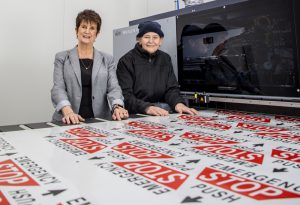
After some research, she met up with Durst Oceania managing director Matt Ashman who took her to a local business to see a Durst sign making press in operation, and have a closer look at the press’ features and functionality.
“It was then that I knew we had to get a Durst sign making machine. We decided to bring in the Durst Rho 163 TS HS traffic sign printer, and have added to our fleet laminating machines, a Sign-Master applicator machine and a MultiCam cutting machine,” Wen said.
“All in all, we’ve invested around $1 million to develop our sign making sector.”
Ashman said he found LVE’s background and desire to drive innovation within its segment, coupled with Wendy’s aims to propel the organisation forward, as a unique factor in its establishment within the traffic signs industry.
“The traffic signs market within Australia is quite tight knit. Wendy saw a chance to bring LVE into this market, which is something it has never been known for, to expand its portfolio and that’s remarkable,” Ashman said.
According to Ashman, the traffic signs market in Australia has traditionally been a mechanical industry, requiring these solutions to be produced in a traditional, manual way that conforms to very strict State and Federal Government rules and outdoor requirements and safety.
“With these regulations in mind, around 10 years ago, Durst partnered with a major global media and ink manufacturer to produce a certified, digital version of the traditional process. Matching a new Durst machine (Rho TS versions) with special ink, media and over laminate resulted in a certified road sign with a 10-year outdoor warranty,” Ashman said.
“The machine that LVE has invested in is one of our newer-generation models, which has the ability to print traffic signage with the standard traffic signage colours and also render within a traffic sign a full-coloured image or corporate logo.
“This versatility was not possible to achieve until the launch of the Rho 163 TS product lineup.”
Up and running at LVE
The installation process of the Rho 163 TS HS traffic sign printer was slightly hiccupped by the crisis and effects surrounding COVID-19.
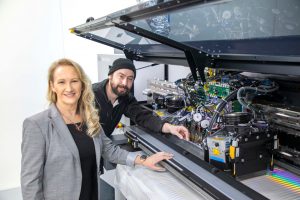
The printer was expected to be installed in March but since this was at the height of COVID-19 lockdowns worldwide, it didn’t arrive at LVE until May.
“The Durst team handled the situation extremely well; the delays were challenging for everyone as it was something that was out of the hands of Durst. The printer, when it managed to leave Europe, had to be fumigated when it arrived in Australia, which also caused some delays,” Wen said.
“But apart from that, Durst coordinated for the printer to arrive at LVE at the soonest time possible.”
Ashman said Durst followed state and regional regulatory requirements during the install and got the unit on site, with social distancing protocols adhered to, within a couple of days.
“We already had completed the necessary PPE, social distancing measures, and risk assessments to proceed with the installation and once the printer hit our shores, we got it to LVE as soon as we could,” he said.
Since installation, the press has become the dominant piece of equipment at LVE and has been fully operational since June, without missing a beat.
“All of our sign printing work goes through the Durst machine; it’s only if it is busy that we utilise our other machines. We try and keep it busy all day, every day,” Wen said adding that the printer has also delivered “massive improvements” in LVE’s productivity and efficiency.
“With the older Roland machines, we could only produce three large signs per day but with the Durst Rho 163 TS HS, we’re able to produce that same number in 15 minutes at most,” Wen said.
“It’s just about the absolute speed of that we can get work done.
“And even when we were making traffic signs before, we were making them in an old-fashioned way where we had to lay down the reflective vinyl and weed out the lettering to put onto the top later.

“We took two weeks to make 26 signs before the Durst install. Once we got the Durst press, we were able to make 92 traffic signs in three hours, and that will improve further as we become more efficient with our new equipment.
“It has literally transformed our department’s operations.”
All of LVE’s staff had to be educated on how to use the printer, providing them with an opportunity to upskill and learn the trade on this modern-day equipment.
“Durst sent its technicians on-site and we got our supervisors and admin staff trained for the new printer,” Wen said.
“With that expertise, we have methodically trained our supported workers, teaching them each of the little steps in using the new machine. One of our supported employees is deaf and mute and has worked in our vinyl room for a number of years.
“He has now learnt how to pull the traffic signs together and apply the Durst printed vinyls onto the backings.
“It has also given us so much more in terms of efficiencies and we have also set up the layout of our machines in a leaner methodology following the installation of the Durst printer.
“Our workspace now has a flow and is more purposeful.”
Ashman said having LVE under its client banner could potentially extend its reach into new areas of business.
“Any new client in any new sector is of great value to Durst. LVE, operating in the social enterprise space, has expanded our reach. Our aim is to be able to bring Durst into businesses to provide solutions for all business, not just for traditional printers,” he mentioned.
“From this partnership with LVE, other businesses of similar operations can learn that innovation is key. They need to look at new ways of doing things to offer new products and services by investing in new technology.”
A complete Durst turnkey solution for LVE
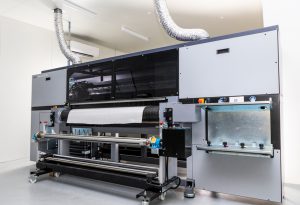
LVE also has plans to invest in Durst’s web-to-print Smart Shop solution, which will enable LVE’s customers with a personalised and branded platform that offers more creativity and flexibility when it comes to product design. LVE is currently in the midst of refreshing and redeveloping its website, and once ready in the coming months, aims to have the Durst Smart Shop platform integrated with its system.
The Durst Smart Shop platform will not only enable LVE to sell products online but also sell custom products online.
It has a fully-featured design tool for customers to design signage on the website, and preview it in either 2D or augmented reality 3D using a smartphone, amongst other advanced features.
“It provides the technology smarts for our back-end and allows us to provide our customers with a more comprehensive service,” Wen added.
“This investment with Durst will open up a lot of doors for LVE.
“It will not only provide us with the opportunity to sustain our business for a long time to come, but also have the ability to deliver on a variety of national projects across Australia.”
Comment below to have your say on this story.
If you have a news story or tip-off, get in touch at editorial@sprinter.com.au.
Sign up to the Sprinter newsletter

